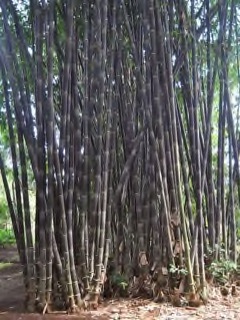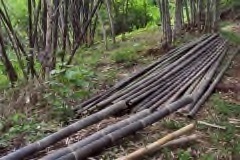 |
|
wikimedia.org Wibowo Djatmiko (Wie146) |
 |
| wikimedia.org Wibowo Djatmiko (Wie146) |
Translate this page:
Summary
Physical Characteristics

 Gigantochloa atroviolacea is an evergreen Bamboo growing to 12 m (39ft) by 4 m (13ft) at a medium rate.
Gigantochloa atroviolacea is an evergreen Bamboo growing to 12 m (39ft) by 4 m (13ft) at a medium rate.
See above for USDA hardiness. It is hardy to UK zone 10. The flowers are pollinated by Wind.
Suitable for: light (sandy), medium (loamy) and heavy (clay) soils and prefers well-drained soil. Suitable pH: mildly acid and neutral soils. It can grow in semi-shade (light woodland) or no shade. It prefers moist soil.
UK Hardiness Map
US Hardiness Map
Synonyms
Gigantochloa atter nigra Gamble
Plant Habitats
Edible Uses
Edible Parts: Shoots
Edible Uses:
The young shoots are edible, turning yellow-pinkish after cooking[310 ].
References More on Edible Uses
Medicinal Uses
Plants For A Future can not take any responsibility for any adverse effects from the use of plants. Always seek advice from a professional before using a plant medicinally.
None known
References More on Medicinal Uses
The Bookshop: Edible Plant Books
Our Latest books on Perennial Plants For Food Forests and Permaculture Gardens in paperback or digital formats.

Edible Tropical Plants
Food Forest Plants for Hotter Conditions: 250+ Plants For Tropical Food Forests & Permaculture Gardens.
More

Edible Temperate Plants
Plants for Your Food Forest: 500 Plants for Temperate Food Forests & Permaculture Gardens.
More

More Books
PFAF have eight books available in paperback and digital formats. Browse the shop for more information.
Shop Now
Other Uses
The thin culm has specific features that make it suitable for the manufacture of the famous bamboo musical instruments angklung, calung, gambang and celempung[310 ]. In the past the culms were exclusively used for this purpose, but the peculiar blackish culms have now also caught the attention of the handicraft and furniture industries, so that at present most of the culms disappear into these industries, creating a shortage of material to make musical instruments.[310 , 361 ]. The culms grow up to 12 metres tall, they are 6 - 8 cm in diameter at the base, the wall is up to 8 mm thick, with internodes up to 40 - 50 cm long[310. The canes are dark green when young, turning greenish to dark brownish-purple with age, with distinct pale or whitish rings at the nodes, covered by dark brown glabrescent hairs[310 ].
Special Uses
Carbon Farming
References More on Other Uses
Cultivation details
Industrial Crop: Biomass Management: Managed Multistem Regional Crop
Grows well in the perhumid lowland tropics, with an annual rainfall of 1,500 - 3,700 mm, relative humidity of over 70% and average temperature of 20 - 32°c[310 ]. In Java it occurs mostly on red and reddish-brown latosols and lateritic soils, but it prefers drier limestone soils. In dry areas the purplish colour of the culms is more prominent[361 ]. A slow growing bamboo, usually only 1 - 2 young shoots arise from the rhizome at the base of an old culm so that clumps are usually smaller than those of other bamboos[310 ]. However, it has been recorded that 2 years after planting 15 culms can be present[310 ]. Bamboos have an interesting method of growth. Each plant produces a number of new stems annually - these stems grow to their maximum height in their first year of growth, subsequent growth in the stem being limited to the production of new side branches and leaves. In the case of some mature tropical species the new stem could be as much as 30 metres tall, with daily increases in height of 30cm or more during their peak growth time. This makes them some of the fastest-growing species in the world[K ]. Culms reach their maximum length within 5 months. The average growth rate is about 9 cm per day[310 ]. Culm size increases with the age of the clump; average height is 3 metres in the first year after planting, 6.4 metres in the 2nd and 9.3 metres in the 3rd; average diameter increases from 2.2 cm in the first year, 5.5 cm in the 2nd, to 7.6 cm in the 3rd year after planting[310 ]. Harvesting may start 4 - 5 years after planting. It is recommended to harvest only in the dry season[310 ]. The average yield of mature clumps is estimated at 20 culms per 3 years (or with 200 clumps per ha, about 4000 culms per ha every 3 years)[310 ]. Traditionally, harvested culms are immersed in running or stagnant water for 15 - 30 days and then air dried[310 ]. Chemical preservation is possible by soaking the culms in a 5% borax solution for 3 days. Penetration in the walls of whole culms is about 50% for borax[310 ]. Branching starts by the formation of some rudimentary branches at the first node from below. Then branching continues at about the 10th node from the top, followed by the next two nodes down, and then development continues both up and down the culm from this area until branches have been produced from all nodes situated higher than 2 - 3 metres from the ground[310 ]. Bamboos in general are usually monocarpic, living for many years before flowering, then flowering and seeding profusely for a period of 1 - 3 years before usually dying.
Carbon Farming
-
Industrial Crop: Biomass
Three broad categories: bamboos, resprouting woody plants, and giant grasses. uses include: protein, materials (paper, building materials, fibers, biochar etc.), chemicals (biobased chemicals), energy - biofuels
-
Management: Managed Multistem
Regularly removing some multiple stems. A non-A non-destructive management systems maintaining the soil organic carbon.
-
Regional Crop
These crops have been domesticated and cultivated regionally but have not been adopted elsewhere and are typically not traded globally, Examples in this broad category include perennial cottons and many nuts and staple fruits.
References Carbon Farming Information and Carbon Sequestration Information
Temperature Converter
Type a value in the Celsius field to convert the value to Fahrenheit:
Fahrenheit:
The PFAF Bookshop
Plants For A Future have a number of books available in paperback and digital form. Book titles include Edible Plants, Edible Perennials, Edible Trees,Edible Shrubs, Woodland Gardening, and Temperate Food Forest Plants. Our new book is Food Forest Plants For Hotter Conditions (Tropical and Sub-Tropical).
Shop Now
Plant Propagation
This species is only propagated vegetatively[310 ]. Rhizome or culm cuttings. In an experiment in Indonesia, 1-noded, 20 cm long cuttings of one-year-old culms were used in a nursery protected against heavy rains. Survival rate was 60%. Transplanting to the field was carried out about one year later, when the plants were about 75 cm tall[310 ].
Other Names
If available other names are mentioned here
Awi hideung, Bambu hitam, Clumping bamboo, Pring wulung
Native Range
Coming Soon
Weed Potential
Right plant wrong place. We are currently updating this section.
Please note that a plant may be invasive in one area but may not in your area so it's worth checking.
None Known
Conservation Status
IUCN Red List of Threatened Plants Status : This taxon has not yet been assessed

Growth: S = slow M = medium F = fast. Soil: L = light (sandy) M = medium H = heavy (clay). pH: A = acid N = neutral B = basic (alkaline). Shade: F = full shade S = semi-shade N = no shade. Moisture: D = dry M = Moist We = wet Wa = water.
Now available:
Food Forest Plants for Mediterranean Conditions
350+ Perennial Plants For Mediterranean and Drier Food Forests and Permaculture Gardens.
[Paperback and eBook]
This is the third in Plants For A Future's series of plant guides for food forests tailored to
specific climate zones. Following volumes on temperate and tropical ecosystems, this book focuses
on species suited to Mediterranean conditions—regions with hot, dry summers and cool, wet winters,
often facing the added challenge of climate change.
Read More
Expert comment
Author
Widjaja
Botanical References
Links / References
For a list of references used on this page please go here
A special thanks to Ken Fern for some of the information used on this page.
Readers comment
| Add a comment |
|
If you have important information about this plant that may help other users please add a comment or link below. Only comments or links that are felt to be directly relevant to a plant will be included. If you think a comment/link or information contained on this page is inaccurate or misleading we would welcome your feedback at [email protected]. If you have questions about a plant please use the Forum on this website as we do not have the resources to answer questions ourselves.
* Please note: the comments by website users are not necessarily those held by PFAF and may give misleading or inaccurate information.
To leave a comment please Register or login here All comments need to be approved so will not appear immediately.
|
Subject : Gigantochloa atroviolacea
|
|
|
|